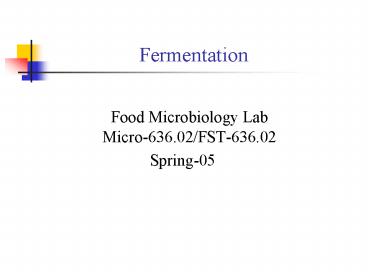Fermentation - PowerPoint PPT Presentation
1 / 13
Title: Fermentation
1
Fermentation
- Food Microbiology Lab Micro-636.02/FST-636.02
- Spring-05
2
Fermentation
- In industry, use of microorganisms or their
- enzymes to convert an organic compound to
- another compound
- Purpose
- Produce microbial cells (yeast)
- Produce microbial enzymes (amylase)
- Produce microbial metabolites
- Primary metabolites acid, alcohol, amino acids
- Secondary metabolites bacteriocins,
antibiotics - Produce high-value compounds (hormones)
3
Fermented foods
- Dairy Products
- Cheese, yogurt, sour cream
- Non-dairy products
- Sauerkraut, pickles
- Beer, wine
- Sausage
- Soy sauce
4
Fermentation systems
- Batch
- Nothing is added or removed from the fermentor
after inoculation - Continuous
- Fresh supply of medium is added continuously at
the same rate as the fermentate is withdrawn
5
Fermentor and parameters
Inoculation port
Thermocouple
Gas exhaust
Thermometer
pH electrode
Gas inlet
Heat exchanger inlet
Heat exchangeroutlet
- Agitation
- Impeller
- Aeration
- Sparger and impeller
- Temperature
- pH
Sampling ports
Metal head
Glass jar
Impeller
Gas sparger
6
Fermentation System
pH meter Attached to pH electrode
Sample collection line
Flow of data
Fermenter
Fraction collector
Computer with data acquisition device
Refrigerator
Spectrophotometer with flow cell
0.000
Flow of fermentate
Pump
7
Lactic acid bacteria (LAB)
- G, non-spore forming cocci or rods
- Microaerophilic or anaerobic
- Metabolize carbohydrates through fermentative
pathways - Acid production as the major end-product
- Common genera
- Lactococcus, Lactobacillus, Leuconostoc,
Pediococcus, Streptococcus, Oenococcus
8
Bacteriocins
- Antimicrobial peptides produced by some bacteria
that inhibit closely related species - Membrane-active agents that form pores in
cytoplasmic membrane and dissipate proton-motive
force - Significant in food safety to control pathogens
- Lactococcus lactis subsp. lactis and NISIN
9
Nisin
- Class I bacteriocin lantibiotic, lt5 KDa
- Producer Lactococcus lactis subsp. lactis
- Active against G bacteria (Clostridium
botulinum, Listeria monocytogenes, LAB) - Commercially available
- Cheese and dairy products, canned foods,
mayonnaise - Only bacteriocin approved for use in U.S.
10
Day 1
- Tour of fermentation lab
- Observing bench-top fermentor
- Start fermentation
- Inoculum Lactococcus lactis subsp. lactis ATCC
11454 - Medium MRS broth
- Duration 24 hour
- Measurements Absorbance and pH
- Fermentate sampling Continuously at time
intervals
11
Day 2. Bacteriocin bioassay
MRS agar plate
Fermentate sample
Overlay with soft MRS agarseeded with sensitive
indicator
Centrifuge
Nisin standard solution
Leave plates undisturbed for 45-60 min
Microfilter the supernatant
Prepare 2-fold dilutions
Dispense 5 ?l of filtered fermentate and nisin
dilutionsonto the soft agar overlay
Leave plates undisturbed for 45-60 min
Incubate plates at 35C for 48 hours
Measure diameter of inhibition area
?
Day 3
Construct a dose-response plot
Determine nisin concentration in the fermentate
12
Nisin bioassay
13
Extra credit !!!!
- Sample automatically gathered data every 15
minutes. Plot the automatically gathered growth
data (A600nm) and pH against fermentation time.
Use left Y-axis for A600nm and right Y-axis for
pH. Label the axes properly and provide suitable
title (2 pts.) - Due Friday June 3rd by 1130 am













![Precision Fermentation Ingredients Market: Trends, Opportunities, and Forecasts [Latest] PowerPoint PPT Presentation](https://s3.amazonaws.com/images.powershow.com/9995646.th0.jpg?_=20240206014)






![[PDF READ ONLINE] Beginner’s Guide to Pickling & Fermentation: A Complete Cookbook for Pi PowerPoint PPT Presentation](https://s3.amazonaws.com/images.powershow.com/10080078.th0.jpg?_=202407170610)










